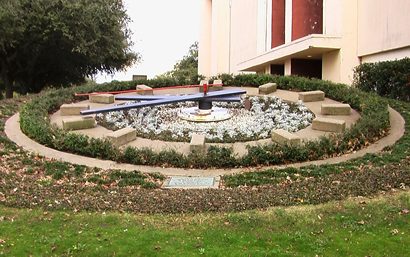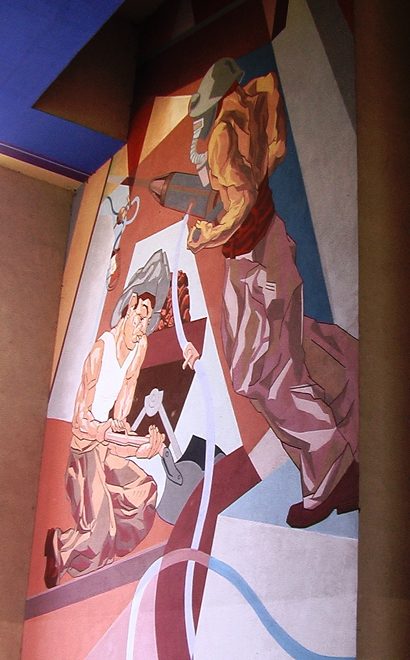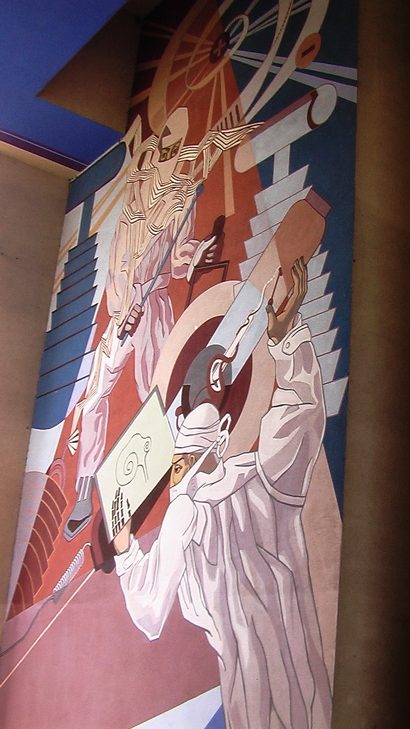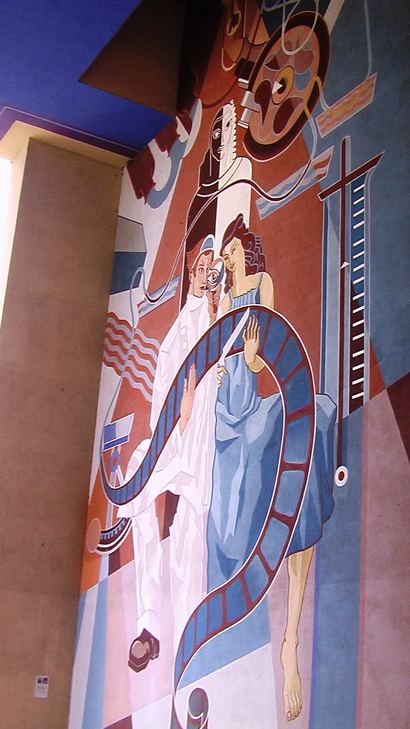|
Although
similar in nature to the Centennial
Building with its exterior and 650-foot length, the Automobile
has a very different past. It stands on the ground previously occupied
by a wooden building. Built in 1913, the facility was used for displaying
cars. The Automobile and Manufacturers Building took its place in
1922 as a larger and more sturdy place for the shows. George Dahl
remodeled it for the exposition, then placed two buildings on each
side. Forming one structure, the Pavilion of Electricity, Communication,
and Industry had three statues and six murals just like its partner
across the pool. However, the artwork was designed by different
people. Raoul Josset
and José Martin worked on the statues while Pierre Bourdelle focused
on the murals. The concrete structures represented the nations of
Mexico, France, and the United States. Instead of reflecting the
different modes of transportation, the murals depicted the different
types of professions being representing inside the pavilion.
Five years after the Pan American Expo, which took place in 1937,
a fire completely destroyed the building and all its murals. The
statues still remained, but they stood alone until 1948. The Automobile
Building, originally called the Pavilion of the Automobile,
was constructed at the cost of 800,000 dollars that year. Designed
by Walter Ahlschlager, it had no murals or porticoes. The new structuring
meant that the statue would stay separated from the main facility.
This separation ended in 1985 when porticoes were added in preparation
for the Texas Sesquicentennial.
In 1999, the State Fair Association provided funds for the Friends
of Fair Park, a non-profit citizens' group, to reconstruct the decimated
murals. EverGreene Painting Studios from New York City performed
the task and completed it the same year. Using Bourdelle's original
glass slides, workers projected the artist's drawings onto the paper
covering the wall. They then punched holes with a brass wheel over
the design. The artists took pounce powder and applied it to add
lines to the wall. Once this was accomplished, they painted the
new murals using drawings and photographs as references. For the
final step, the murals received a mineral-based coating to protect
them from fading.
|
 |
The
Flower Clock
Photo courtesy Clint Skinner, February 2016 |
|
On
the southern side near the front of the esplanade pool, a flower
clock pays tribute to former mayor Austin Starke Taylor, Jr. as
a symbol of friendship with the city. Received in 1986 by Steven
M. Park, the project design manager of the Dallas Park and Recreation
Department, the clock was a gift from Mr. Cho, the president of
a Japanese company named Samhwa. The president insisted, however,
that his grandson Tatuya Hakata should be the one credited for sending
the donation. The final cost of installing the gift reached 12,952
dollars. The dedication of the flower clock took place in June 1987.
|
France
Portico
Photo courtesy Clint Skinner, February 2016 |
|
The
statue of the first portico that visitors encounter represents the
nation of France. Its flag flew over Texas from 1685 to 1690. The
period began with the establishment of a colony by René-Robert
Cavelier, Sieur de La Salle. The French explorer began his working
career as a wealthy merchant. After a brief tenure training to be
a priest, La
Salle gave up the profession and moved to Canada in 1666. He
settled in an area near Montreal then started getting involved with
the fur trade. Tales about a large river that intersected with the
Mississippi River and reached the Gulf of California soon entered
La
Salle's ears. If true, it would mean a better route to China.
La
Salle decided to take a chance, selling his fortune to finance
the trip. He made it all the way to the Ohio River, but crew desertions
forced him to turn back. He then went on a series of expeditions
that resulted in the establishment of forts and outposts in the
Great Lakes region and along the Ohio, Illinois, and Mississippi
rivers. After naming the land serviced by the Mississippi, La Louisiane
in honor of King Louis XIV, La
Salle returned to his original homeland in 1683.
La
Salle managed to obtain royal support for a voyage to the Mississippi
River, using a water route instead of a land-based one. He hoped
to travel along the Gulf of Mexico and establish a settlement and
fort near the Great River. The journey started in 1684. After a
series of misfortunes, La
Salle's crew became lost and mistook the Matagorda Bay inlets
for the opening to one the Mississippi's many arms. When it became
apparent that he was wrong about the location, La
Salle, his army, and 180 people set up a colony and built Fort
St. Louis near the Lavaca River in present-day Victoria
County.
Within a period of six months, more than fifty percent of population
died from a combination of disease, sickness, malnutrition, exposure,
exposure, and hard labor. La
Salle made two trips to get his bearings and find the Mississippi
River. During a trip to the Illinois River in hope of finding help
at one of the trading posts, Pierre Duhaut murdered the explorer.
The crew never reached its destination and the situation at Fort
St. Louis worsened. There were only twenty-five settlers left in
1689. That fateful year brought the arrival of a band of Karankawas.
Pretending to be friendly, the Indians entered the small village
and massacred everyone except the five remaining children. All the
kids spent their time living among the Karankawas until the Alonso
De León and Domingo Terán de los Ríos expeditions freed them from
their captivity. When news of the massacre spread the following
year, France showed no more interest and Spain displayed plenty.
|
 |
France
Portico - Miners Mural
Photo courtesy Clint Skinner, February 2016 |
France
Portico - Iron Workers Mural
Photo courtesy Clint Skinner, February 2016 |
Mexico Portico
Photo courtesy Clint Skinner, February 2016 |
|
The
second portico's statue represents the nation of Mexico. Its flag
flew over Texas from 1821 to 1836. Like Spain, the Mexican government
wanted to populate the Texas region but didn't have the resources
to do so. Furthermore, most people were too poor to migrate. This
meant that officials would have to rely on foreigners to move into
the area. Officials decided to use an impresario system to colonize
Texas. An impresario, a land contractor or agent, would obtain a
contract with the government and offer the land to families or individuals.
After buying the land, purchased by the acre, the prospective settlers
would have to swear an oath of loyalty.
The first impresario to arrive on the scene was Moses Austin, who
managed to secure a contract for three hundred families in 1821.
When he died that same year, his son Stephen F. Austin took over
and settled the people along the Brazos and Colorado River. This
was followed by the immigration of at least 2,000 families under
the guidance of impresarios Haden Edwards, Robert Leftwich, Green
DeWitt, and Frost Thorn. Others soon followed as the regulations
became more relaxed. This led to various degrees of corruption and
violence.
As time passed, the Mexican government started to become paranoid
toward the United States, fearing that the nation was making plans
to steal Texas. This resulted in the passage of the Law of April
6, 1830. The legislation made it illegal for any Americans to enter
Texas unless they had a passport. It also forbade the importation
of slaves. The efforts to enforce the new law eventually led to
the Anahuac Disturbances of 1832 and the Battle
of Velasco. From there, the friction between the Mexican government
under Santa Anna and the colonists of Texas escalated into a full-scale
revolution. The Texans won with the victory at San
Jacinto on April 21, 1836.
|
 |
Mexico
Portico - X-Ray Mural
Photo courtesy Clint Skinner, February 2016 |
Mexico
Portico - Wildcatters Mural
Photo courtesy Clint Skinner, February 2016 |
United
States Portico
Photo courtesy Clint Skinner, February 2016 |
|
The
third and final portico has a statue representing the United States
of America. Its flag flew over Texas from 1845 to 1861 and 1865
to the present day. It all started with the nation's annexation,
an issue filled with controversy. With American politics in great
turmoil over slavery and its abolition, many people felt that the
introduction of another slave-holding state would make the situation
worse. They also didn't want to start a war over a territory which
Mexico refused to recognize as an independent nation. Sam
Houston wanted this recognition and managed to get Britain to
mediate a future meeting. In an effort to get the needed support
for re-election, President John Tyler met with Houston
secretly and worked out an annexation deal. His efforts, however,
did not lead to his renomination. Whig candidate James K. Polk,
a man who favored annexation, won at the convention and defeated
Democratic candidate Henry Clay. Tyler then decided to use the election
as a mandate for the passage of the treaty he had made with Houston.
Congress approved it with a simple majority in December 1844. The
following year, the new president signed the annexation agreement
after it had been ratified by the Texas government.
|
 |
United
States Portico - Photographic Process Mural
Photo courtesy Clint Skinner, February 2016 |
United
States Portico - Lensmakers Mural
Photo courtesy Clint Skinner, February 2016 |
|
Texas left the
Union in 1861 to join the Confederacy. After the Civil War, the
state had to comply with a plan of reconstruction in order to officially
enter the Union again. The whole process came to an end in 1870.
Since then, Texas has remained a part of the United States.
|
References:
1.Bigtex.com
2.Dallashistory.org
3.Dallas Morning News Archives
4.Fairpark.org
5.Slate, John H. Historic Dallas Parks. Arcadia Publishing, 2010.
6.Tshaonline.org
7.Watermelon-kid.com
8.Wikipedia.org
8.Winters, Willis Cecil. Fair Park. Arcadia Publishing, 2010. |
|
|
| Texas
Escapes, in its purpose to preserve historic, endangered and vanishing
Texas, asks that anyone wishing to share their local history, stories,
landmarks and vintage or recent photos, please contact
us. |
|
|
